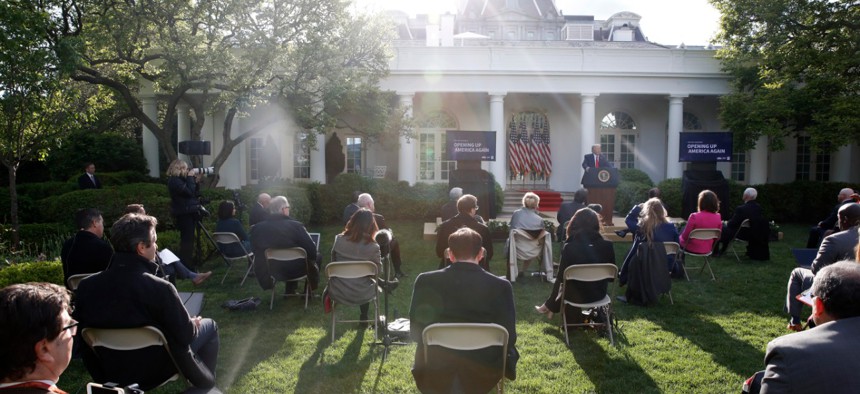
President Trump speaks about the coronavirus in the Rose Garden of the White House on April 27. Alex Brandon / AP
Trump Administration's High Turnover and Vacancy Rates Could Hinder Pandemic Response
The administration has seen an 85% turnover rate among upper-level officials.
High turnover and vacancy rates in the Trump administration could hinder its response to the coronavirus pandemic because agencies lack upper-level officials with deep institutional knowledge and experience in some critical areas, experts said on Wednesday.
Over the course of the Trump administration, there has been an 85% turnover rate among upper-level administration officials, which is much higher than that for any other presidential administration in the past 40 years, according to the Brookings Institution. During a webinar hosted by the think tank on Wednesday afternoon, government and administrative law experts discussed what the struggle to recruit and retain appointees could mean for the Trump administration’s ability to respond to the pandemic.
“If anything we’re taught as political scientists or social scientists ... that causation is something you want to shy away [from],” said Kathryn Dunn Tenpas, a nonresident senior fellow with Brookings’ Governance Studies and a fellow and secretary of the Governance Institute. “But I think it’s hard to deny the fact that when you have so much turnover you don’t have the stable relationships where they can contact people in agencies, where they know each other. It’s much easier to work with somebody at the [Food and Drug Administration] or [Homeland Security Department] or whichever department or agency if you know them.”
For example, by having four White House chiefs-of-staff since 2017, “the prospect of somebody being able to effectively create a whole of government response to a pandemic is much more complicated and much more difficult,” she said. In contrast, the Obama administration, which dealt with the H1N1 flu and Ebola outbreaks and Hurricane Sandy, had much higher retention rates “and therefore a lot of these people knew each other [and] worked together repeatedly.”
Tenpas added, “It’s not just the sheer number of vacancies, it’s where those vacancies are at a time like” the coronavirus pandemic. She noted the Homeland Security Department, which has been a key agency in the administration’s pandemic response, has not had a Senate-confirmed head since Kirstjen Nielsen left her position as secretary on April 10, 2019.
Anne Joseph O’Connell, a law professor at Stanford University who specializes in administrative law and the federal bureaucracy, also said that causal claims are tricky.
“Generally we think vacancies and high turnover are bad for government performance. We have some prior work on this,” she said, citing research by Vanderbilt University Professor David Lewis on Homeland Security’s response to Hurricane Katrina in 2005 and Paulette Goddard Professor of Public Service at New York University Paul Light’s study with Brookings on government failures between 2001 and 2014.
“On the other hand, there might be instances where you have senior careerists leading up critical functions in the government instead of a campaign bundler whom the president wants to appoint and that might turn out to be better for government performance,” O’Connell said.
She also said you have to pair the vacancies issue with the quality of those individuals in the jobs. In her report published in February, she recommended Congress require that senior agency officials have served in the agency for a minimum of five years to be eligible to serve as an acting head, instead of the current 90-day minimum. She also recommended shortening the total amount of time an acting official can serve to balance the typical delays of the confirmation process (such as the vetting process and political fights in the Senate) and “incentivize the White House to use the appointments process.”
The Trump administration’s high levels of turnover and vacancies have not ceased during the pandemic. Since mid-March, several officials, some at agencies central to the pandemic response, have either resigned or been fired. This includes: U.S. Agency for International Development Administrator Mark Green; Biomedical Advanced Research and Development Authority Director Dr. Rick Bright; Intelligence Community Inspector General Michael Atkinson; and Glenn Fine, acting Pentagon inspector general. Fine remains principal deputy inspector general at the Pentagon, the position he held prior to becoming acting IG, but he was stripped of his ability to lead the committee overseeing the government’s pandemic response. These officials have been replaced by acting ones.
Also, The Wall Street Journal reported that the administration is considering replacing HHS Secretary Alex Azar following backlash over his early handling of the pandemic. However, the president tweeted on Sunday evening that the reports were “fake news” and that Azar “is doing an excellent job.”
According to a tracker by The Washington Post and the nonprofit Partnership for Public Service, of the 750 “key” positions that require Senate confirmation, 513 were filled by a confirmed appointee as of Monday, 146 had no nominee, 20 were awaiting a formal nomination but someone had been named to fill the job, and 59 had a formal nominee.
During the coronavirus briefing on April 15, President Trump blamed “partisan obstruction” for the “nominees stuck in the Senate…[who] are nominated for vacancies that must be filled to assist with the coronavirus crisis and the resulting economic challenges.”
The president also said he might “exercise my constitutional authority to adjourn both chambers of Congress,” so he can make recess appointments to fill the positions, which historian Michael Beschloss pointed out is something no president has ever done.







